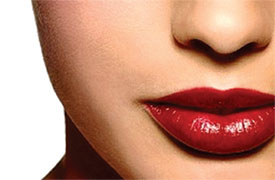The history of red lipstick
Women have come a long way in their quest for the perfect crimson
pout.
Here's how women (and their men) have made it so popular.
One of the first accounts of wearing red lipstick came from the
Mesopotamian women (and often men) who used to adorn their lips with
crushed semi-precious stones. Later, Cleopatra was known for crushing
beetles and ants to get the right shade of scarlet for her lips.
 The phrase ‘Kiss Of Death’ was coined because of the harmful mixture
of fucus-algin, iodine, and bromine mannite that Egyptian women used to
create lipstick. Highly toxic, the concoction often led to serious
illness and sometimes death. The phrase ‘Kiss Of Death’ was coined because of the harmful mixture
of fucus-algin, iodine, and bromine mannite that Egyptian women used to
create lipstick. Highly toxic, the concoction often led to serious
illness and sometimes death.
Frost lipstick even had its first incarnation - fish scales were
ground up to loan lipstick its pearlescent sheen.
By the sixteenth century, the process of making lipstick was a little
safer. Queen Elizabeth 1, who made cosmetics popular, donned a pale
white face of makeup and bright crimson lips that she got from a mix of
beeswax and plants.
Medieval European's were said to believe that lipstick and cosmetics
warded off death - a possible reason why the Queen's ladies-in-waiting
applied makeup to her even post-mortem.
1700s
The popularity of lipstick in the sixteenth century soon took a turn.
The 1700s ushered in a strict anti-cosmetics reign in England where
British Parliament passed a law in 1770 stating that marriages could be
annulled if a woman wore cosmetics before her wedding. Cosmetics were to
be worn only by prostitutes.
However, France had an opposite feeling about cosmetics. Upper class
women were encouraged to wear cosmetics in the 1780’s, as the ‘natural
look’ was to be reserved for prostitutes and working women.
1800s
By the late 1800s, Queen Victoria pronounced makeup to be impolite
and it became unfashionable during her reign. However, some still pushed
the envelope. French actress and early film star, Sarah Bernhardt, was
known to wear red lipstick and even apply it in public - a major taboo
during that time.
In the U.S., lipstick was first advertised in the 1890s in the Sears
Roebuck Catalog. By that time, lipstick was coloured with carmine dye
extracted from cochineal insect scales.
1900-1920s
In the early twentieth century, lipstick became popular again. In
1915, Maurice Levy invented the first metal lipstick tube (before this,
lipstick was made of deer tallow, castor oil, and beeswax and came
wrapped in silk paper - almost impossible to carry in one’s purse). By
1923, the modern swivel lipstick tube was patented and soon, leading
fashion companies started to create lipsticks.
Early film stars (such as Clara Bow, who made the Cupid's Bow popular
by creating it with deep red lipstick) used to wear the darkest lipstick
they could find to mimic red (traditional red's didn't show up on black
and white film).
In the 1930s, marketing and advertising played a huge role in
lipstick sales. Helena Rubenstein, founder and eponym of Helena
Rubenstein makeup, was the first to advertise lipstick as having sun
protection (before SPF was considered important). Also during this time,
manufacturers deemed lipstick ‘an import part of the war effort’, urging
women to do their part and buy lipstick.
Lipstick was becoming scarce because of the war, so chemist Hazel
Bishop developed a ‘No-Smear Lipstick.’ The first of its kind, her
revolutionary lipstick was said to stay put all day.The decade also saw
a surge in propaganda trying to convince young girls that wearing
lipstick was undesirable to men. But, companies relied on marketing
campaigns targeted to their core audiences (girls aged 16 and up) and by
the late 1940s, 90 percent of American women wore lipstick.
By the 1950s, lipstick was deemed acceptable again for all, and even
sexy. Starlets like Marilyn Monroe, Rita Hayworth, Ava Gardner, and
Elizabeth Taylor helped rocket lipstick wear to 98 percent of women in
the U.S.
It was also during this time that Estée Lauder introduced her gift
with purchase program, a sign of the popularity of cosmetic sales.
By the 1960s and 1970s, new colors of lipstick emerged, pushing red
lipstick out of the spotlight once again. In its place, beige and white
lipsticks became popular during the Mod era of the 1960s and during the
1970s, the punk movement saw a surge in black- and purple-hued lipstick.
1980s
By the 1980s, bold reds made a comeback. During this time, the first
line of lipsticks were introduced and Madonna made the Russian Red
colour popular by wearing it throughout her Like a Virgin World Tour.
1990s
The grunge movement of the early ‘90s ushered in brown and plum
shade, popularised by actresses such as Drew Barrymore. Red lipstick was
still a go-to shade for starlets, supermodels, and just about every
woman looking to stand out.
2003
The So-Cal rocker/mother/designer has been rocking her signature
bleached hair and red lipstick for over two decades now. She told
Harper’s Bazaar in 2012: “I remember sitting in my ghetto, beat-up Honda
Prelude and putting on that lipstick in the rear-view mirror and being
like, ‘Uh-huh, I like that. That's it right there.’ I never stopped
after that.”
2009
She may be best known for wearing prosthetics on her face, dresses
made out of meat, or rainbow coloured tresses, but the one thing Gaga
kept going back to was her signature red lipstick.
2012
After the release of her album, Red in 2012, the pop star started
showing up on the red carpet with crimson lacquered lips. Later that
year, she told Redbook: “I’m always wearing red lipstick!”
- Elle
|



